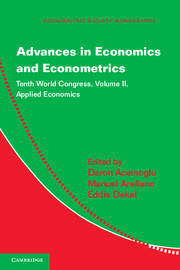Book contents
- Frontmatter
- Contents
- Contributors
- Preface
- I FINANCE
- II POLITICAL ECONOMY
- III MACROECONOMICS
- IV TRADE AND FIRM DYNAMICS
- V GROWTH
- 9 Structural Development Accounting
- 10 Misallocation, Economic Growth, and Input–Output Economics
- VI FRISCH LECTURE
- VII PERSPECTIVES ON CHINESE ECONOMIC GROWTH
- Name Index
- Miscellaneous Endmatter
10 - Misallocation, Economic Growth, and Input–Output Economics
Published online by Cambridge University Press: 05 May 2013
- Frontmatter
- Contents
- Contributors
- Preface
- I FINANCE
- II POLITICAL ECONOMY
- III MACROECONOMICS
- IV TRADE AND FIRM DYNAMICS
- V GROWTH
- 9 Structural Development Accounting
- 10 Misallocation, Economic Growth, and Input–Output Economics
- VI FRISCH LECTURE
- VII PERSPECTIVES ON CHINESE ECONOMIC GROWTH
- Name Index
- Miscellaneous Endmatter
Summary
Introduction
One of the most important developments in the growth literature of the last decade is the enhanced appreciation of the role that the misallocation of resources has in helping us understand income differences across countries. Given an economy's stock of physical capital, labor, human capital, and knowledge, the way in which those aggregate quantities of inputs are allocated across firms and industries – and even potentially within firms – determines the economy's overall level of production. The best allocation will maximize welfare and, in a sense that can be made precise, output itself in the long run. Other allocations result in lower levels of output and therefore show up in the aggregate as a lower level of total factor productivity (TFP).
In a broad sense, this is an old idea with many antecedents. In the realbusiness-cycle literature, for example, it is commonly appreciated that tax distortions or regulations may show up as TFP shocks. Chari, Kehoe, and McGrattan (2007) followed in this tradition.
In the literature on growth and development, Restuccia and Rogerson (2008) explicitly analyzed a model of misallocation among heterogeneous plants to quantify the effect on aggregate TFP. Banerjee and Duflo (2005) argued that the marginal product of capital differs widely among firms in India, potentially reducing overall output. Hsieh and Klenow (2009) presented empirical evidence that misallocation across plants within four-digit industries may reduce TFP in manufacturing by a factor of two to three in China and India. A large literature surrounding these papers considers various mechanisms through which misallocation can lead to income differences.
- Type
- Chapter
- Information
- Advances in Economics and EconometricsTenth World Congress, pp. 419 - 456Publisher: Cambridge University PressPrint publication year: 2013
- 62
- Cited by

